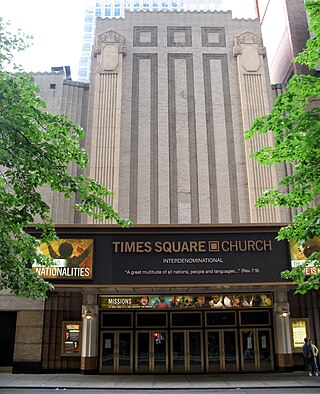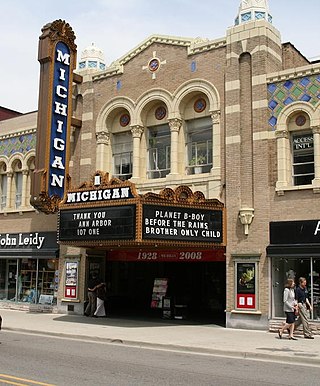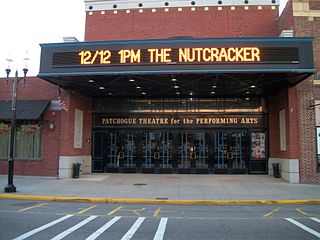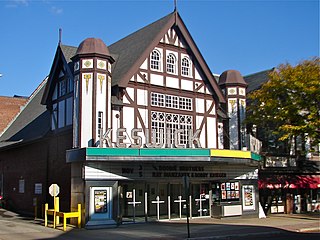
The Mark Hellinger Theatre is a church building at 237 West 51st Street in the Midtown Manhattan neighborhood of New York City, which formerly operated as a cinema and Broadway theater. Opened in 1930, the Hellinger Theatre is named after journalist Mark Hellinger and was developed by Warner Bros. as a movie palace. It was designed by Thomas W. Lamb with a modern facade and a Baroque interior. It has 1,605 seats across two levels and has been a house of worship for the Times Square Church since 1989. Both the exterior and interior of the theater are New York City landmarks.

The Fox Theatre is a performing arts center located at 2211 Woodward Avenue in Downtown Detroit, Michigan, near the Grand Circus Park Historic District. Opened in 1928 as a flagship movie palace in the Fox Theatres chain, it was at over 5,000 seats the largest theater in the city. Designed by theater architect C. Howard Crane, it was listed on the National Register of Historic Places in 1985.

The Michigan Theater is a movie palace in Ann Arbor, Michigan, United States, right adjacent to the Central Campus of the University of Michigan. It shows independent films and stage productions, and hosts musical concerts.

The Grand Lake Theatre is a historic movie palace located at 3200 Grand Avenue and Lake Park Avenue in the Grand Lake neighborhood of Oakland, California.

William Harold Lee was an American 20th century movie theater designer and later the chief architect for Eastern College. He was a protégé of acclaimed Philadelphia architect Frank Furness.

The Arlington Theatre is the largest movie theater and principal performing arts venue in Santa Barbara, California, United States. In addition to regular screenings and artists, it is home to many events associated with the annual Santa Barbara International Film Festival.

The Fox Theater in Spokane, Washington is a 1931 Art Deco movie theater that now serves as a performing arts venue and home of the Spokane Symphony. It was designed by architect Robert C. Reamer, notable for his design of the Old Faithful Inn in Yellowstone National Park. It was part of the Fox Film Corporation Empire founded by studio mogul William Fox. The theater opened September 3, 1931 and showed films continuously until it closed September 21, 2000 after an engagement of the movie Gladiator starring Russell Crowe.

The El Rey Theatre is a live music venue in the Miracle Mile area of the Mid-Wilshire region in Los Angeles, California.

The Arcata Theatre Lounge is a historic structure located in the city of Arcata in Humboldt County, California.

An atmospheric theatre is a type of movie palace design which was popular in the late 1920s. Atmospheric theatres were designed and decorated to evoke the feeling of a particular time and place for patrons, through the use of projectors, architectural elements and ornamentation that evoked a sense of being outdoors. This was intended to make the patron a more active participant in the setting.

Patchogue Theatre for the Performing Arts is Located at 71 East Main Street in Patchogue Village, Suffolk County, New York.

Vogue Theatre is an Art Deco/Art Moderne styled building originally built as a movie house, and currently used as an event venue for the performing arts. Situated on Vancouver’s “Theatre Row", the building was designated as a National Historic Site of Canada in 1993.

The Majestic Theatre is a performing arts theater in the City Center District of Downtown Dallas. It is the last remnant of Theater Row, the city's historic entertainment center on Elm Street, and is a contributing property in the Harwood Street Historic District. The structure is a Dallas Landmark and is listed on the National Register of Historic Places.

The Mississippi Lofts and Adler Theatre is an apartment building and theater complex located in downtown Davenport, Iowa, United States. It is individually listed on the National Register of Historic Places by its original name, the Hotel Mississippi and RKO Orpheum Theater. The Hotel Mississippi was listed on the Davenport Register of Historic Properties in 2005. In 2020 the complex was included as a contributing property in the Davenport Downtown Commercial Historic District.

The Keswick Theatre is a privately owned theater in the Keswick Village section of Glenside, Pennsylvania, a suburb of Philadelphia. Horace Trumbauer designed the exterior in the Tudor Revival Style, which has remained essentially unaltered. When opened it had 1,366 seats.

The Cascade Theatre is a prominent example of the Art Deco style in Redding, California. The cinema was designed by J. Lloyd Conrich of San Francisco in 1934 for the Naify family, who operated the Golden State Theaters chain of movie theaters in northern California, which later became the United Artists Theaters. The new cinema was built in 1935 by Salih Brothers and opened on August 9 with 1348 seats. It was the first air conditioned public building in Redding. In 1979 the large house was subdivided into four smaller theaters, and in 1997 it closed. The Cascade Theatre reopened in 2004 after it was purchased by Southern Oregon University and the JPR Foundation. The house was restored to its original configuration and it is used as a community auditorium and arts center.

The Stavros Niarchos Foundation Parkway, or simply the Parkway, is a movie theater located at 5 West North Avenue in Baltimore, Maryland. The Parkway is open as of May 3, 2017, and is the new permanent home of MdFF. The Maryland Film Festival, a 5-day annual festival created and operated by MdFF, is housed in and around the Parkway and throughout the Station North Arts and Entertainment District.

The Malco Theatre, located at 817 Central Avenue in Hot Springs, Arkansas, was built on a site that has housed vaudeville shows, silent movies, modern films, and specialty productions. The Malco, which was frequented by Bill Clinton as a boy, has played host to the prestigious Hot Springs Documentary Film Institute (HSDFI). The Art Deco building was added to the National Register of Historic Places on January 21, 2010. The Malco is currently home to the Maxwell Blade Theatre of Magic & Comedy.

The Embassy Theatre, also known as the Embassy 1 Theatre, is a former movie theater at 1560 Broadway, along Times Square in the Midtown Manhattan neighborhood of New York City. Designed by Thomas W. Lamb, the theater opened in 1925 at the ground floor of 1560 Broadway, the headquarters of the Actors' Equity Association. While no longer in use as a theater, the space is preserved as a New York City designated landmark, and it continues to operate as a store.




















